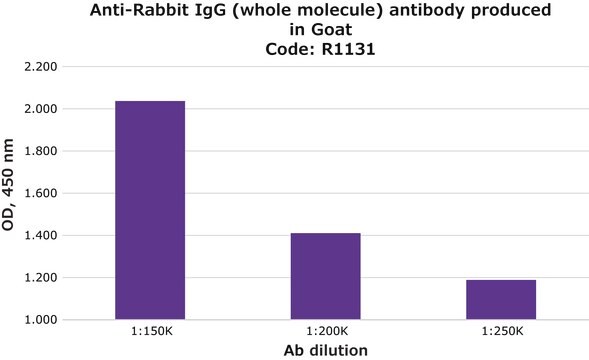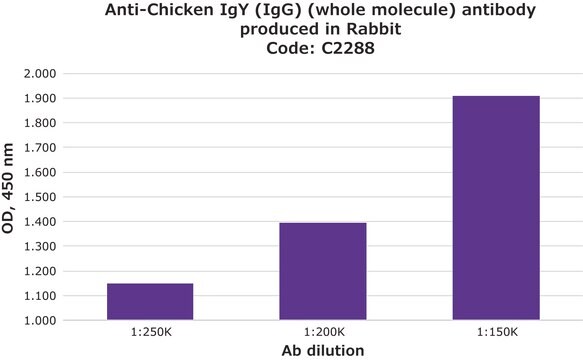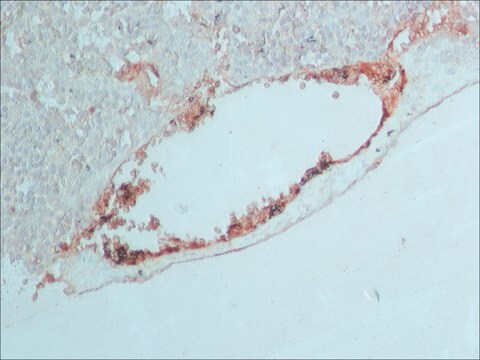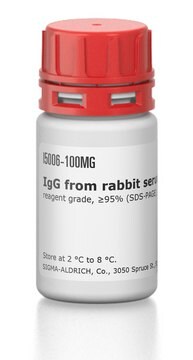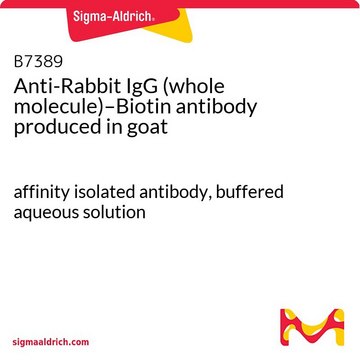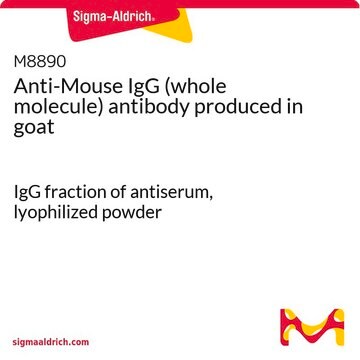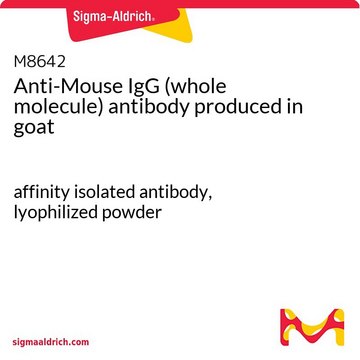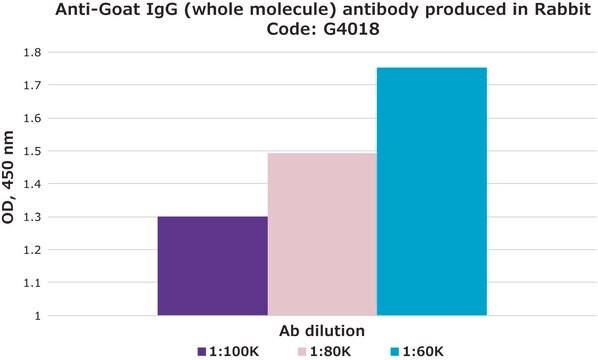R5506
Anti-Rabbit IgG (whole molecule) antibody produced in goat
IgG fraction of antiserum, buffered aqueous solution
Sinônimo(s):
Rabbit IgG Antibody
Faça loginpara ver os preços organizacionais e de contrato
About This Item
Produtos recomendados
fonte biológica
goat
Nível de qualidade
conjugado
unconjugated
forma do anticorpo
IgG fraction of antiserum
tipo de produto de anticorpo
secondary antibodies
clone
polyclonal
Formulário
buffered aqueous solution
técnica(s)
indirect ELISA: 1:30,000
quantitative precipitin assay: 3.0-4.5 mg/mL
Condições de expedição
dry ice
temperatura de armazenamento
−20°C
modificação pós-traducional do alvo
unmodified
Procurando produtos similares? Visita Guia de comparação de produtos
Descrição geral
Immunoglobulins (Igs) belong to the immunoglobulin super-family and have two heavy (H) and two light (L) chains, held together by disulfide linkages. The heavy chain has one variable N-terminal region and three to four constant (CH1-CH4) C-terminal regions. The L chain comprises of one variable N-terminal region and a constant C-terminal region. IgG is an abundant protein in human serum. The four classes of IgG include IgG1, IgG2, IgG3 and IgG4. The IgG heavy chain region is mapped to human chromosome 14.
Rabbit immunoglobulins (IgGs) are often used as primary antibodies in several protein assays. Thus, anti-rabbit IgGs can be used as secondary antibodies to study and characterize target proteins bound to rabbit IgGs. Anti-Rabbit IgG (whole molecule) antibody is specific for IgGs in rabbits.
Especificidade
Anti-Rabbit IgG (whole molecule) antibody is specific for IgGs in rabbits.
Imunogênio
Rabbit IgG
Aplicação
Anti-Rabbit IgG (whole molecule) antibody is suitable for use in quantitative precipitin assay, immunoelectrophoresis, immunohistochemistry , and laser scattering microscopy .
Anti-Rabbit IgG (whole molecule) antibody produced in goat has been used as secondary antibody in vivo xenograft assay in non-small-cell lung cancer (NSCLC) tissues and in western blotting detection in endometrial sample from cattle.
Ações bioquímicas/fisiológicas
Digestion of IgG by papain results in the generation of fragment antigen binding (Fab). Pepsin digestion of IgG produces fragment crystallizable (Fc). The Fc region of IgG antibody has enormous therapeutic potential and is exploited for the development of therapeutic antibodies. IgG1 class is the most abundant and its deficiency results in hypogammaglobulinemia. IgG2 deficiency increases susceptibility to bacterial infections. IgG3 mediates effector functions, and IgG4 is associated with asymptomatic infection.
forma física
Solution in 0.01 M phosphate buffered saline pH 7.4, containing 15 mM sodium azide as preservative
Armazenamento e estabilidade
For continuous use, store at 2-8 °C for up to one month. For extended storage, the solution may be frozen in working aliquots. Repeated freezing and thawing, or storage in "frost-free" freezers is not recommended. If slight turbidity occurs upon prolonged storage, clarify the solution by centrifugation before use.
Exoneração de responsabilidade
Unless otherwise stated in our catalog or other company documentation accompanying the product(s), our products are intended for research use only and are not to be used for any other purpose, which includes but is not limited to, unauthorized commercial uses, in vitro diagnostic uses, ex vivo or in vivo therapeutic uses or any type of consumption or application to humans or animals.
Não está encontrando o produto certo?
Experimente o nosso Ferramenta de seleção de produtos.
Código de classe de armazenamento
10 - Combustible liquids
Escolha uma das versões mais recentes:
Já possui este produto?
Encontre a documentação dos produtos que você adquiriu recentemente na biblioteca de documentos.
Os clientes também visualizaram
The newly established bovine endometrial gland cell line (BEGC) forms gland acini in vitro and is only IFNtau-responsive after E2 and P4-pre-incubation.
Haeger JD, et al.
Placenta, 15(2), 1633-1639 (2018)
Steven Johnson et al.
Nature microbiology, 6(6), 712-721 (2021-05-02)
The bacterial flagellum is a macromolecular protein complex that enables motility in many species. Bacterial flagella self-assemble a strong, multicomponent drive shaft that couples rotation in the inner membrane to the micrometre-long flagellar filament that powers bacterial swimming in viscous
Junhua Yuan et al.
Proceedings of the National Academy of Sciences of the United States of America, 105(4), 1182-1185 (2008-01-19)
Flagellated bacteria, such as Escherichia coli, are propelled by helical flagellar filaments, each driven at its base by a reversible rotary motor, powered by a transmembrane proton flux. Torque is generated by the interaction of stator proteins, MotA and MotB
MicroRNA-30a suppresses non-small-cell lung cancer by targeting Myb-related protein B.
Geng GJ, et al.
Experimental and Therapeutic Medicine, 15(2), 1633-1639 (2018)
D Bässler et al.
The Journal of experimental biology, 199(Pt 11), 2369-2382 (1996-11-01)
1. The common inhibitory motoneurone 1 (CI1) in the mesothoracic ganglion of the locust was photoinactivated using a helium-cadmium laser or a mercury lamp as light source. Treated animals showed no signs of abnormal locomotory behaviour over periods of up
Nossa equipe de cientistas tem experiência em todas as áreas de pesquisa, incluindo Life Sciences, ciência de materiais, síntese química, cromatografia, química analítica e muitas outras.
Entre em contato com a assistência técnica

